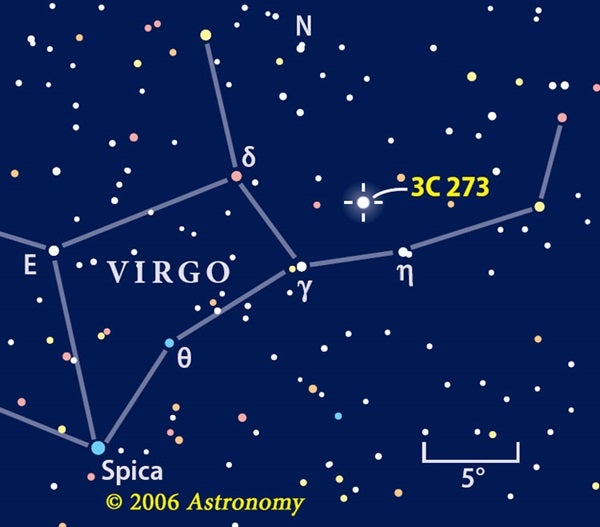“Would you like to see a supernova?”
I asked the group. The opportunity to view firsthand something they had learned about in science class was too good to pass up. I warned them they would be looking at an ordinary, starlike point of light, not something as spectacular as the exploding Death Star in Star Wars.
When the first student peered into the eyepiece, I asked if he could see a fuzzy oval blob. This, I told him, is the nucleus of M81 — a galaxy 11 million light-years away. I then directed his attention to a triangle of stars close to the nucleus.
“See the star in the triangle that’s farthest from the other two?” I prompted. “That’s the supernova. The other two are Milky Way stars just a few hundred light-years away at most. The supernova lies on the outer edge of M81. You’re looking at a star that exploded 11 million years ago!”
This month, I’d like to introduce you to a cerebral “wow” object that puts the M81 supernova to shame — 3C 273. As the brightest and one of the nearest quasars, it appears as an obscure 13th-magnitude star through a telescope. Even though I’ve glimpsed it in a 4-inch reflector, 3C 273 appears better when viewed in a scope at least 6 inches in aperture.
3C 273 lies in the constellation Virgo, a short star-hop from the star Eta (η) Virginis. The AAVSO “b” chart for the variable star SS Virginis maps the route nicely. To get a copy, go to the AAVSO web site. Click on “Charts” on the left side of the screen, and then type in “SS Vir” in the box next to “Name.” Select the “B(GIF)” chart — or “BR(GIF)” if you have a refractor or Catadioptric scope whose star diagonal produces a mirror image. To pinpoint your target, you’ll also need the AAVSO “D” chart for 3C 273.
As you gaze at this tiny point of light, ponder its significance. A quasar is the active core of a distant galaxy. Possibly no more than a few light-months across, 3C 273 releases as much light as 10 trillion Suns — 100 times the output of the entire Milky Way Galaxy. This output’s source seems to be a supermassive black hole at the galaxy’s core that releases incredible quantities of light as it swallows up surrounding gas and unfortunate stars.
If 3C 273 were 32 light-years away (about the same distance as the star Arcturus), it would shine in our sky as brightly as the midday Sun. At its distance of 2 billion light-years, it’s the most remote object visible in ordinary telescopes. The light collected by your telescope and transported to your eyes left this quasar at a time when the dominant life-forms on Earth, single-celled organisms, drifted about in the Precambrian ocean. Larger earthly life-forms, like worms and jellyfish, were still a billion years from existence. Wow!
For those of you who don’t yet have the observing know-how to star-hop your way to 3C 273, or lack a telescope big enough to capture it, a familiar friend awaits — Jupiter. The planet that has captivated astronomers since Galileo’s time (1564–1642) will put on a grand show in even the smallest telescope. Low power (30x-50x) will reveal Jupiter’s slightly flattened, banded disk. With this same magnification, you can see the planet’s four bright Galilean moons. Think of this as you gaze: If our Earth were “out there” with this colossal planet, it would be just another of Jupiter’s moons — brighter than the others, but still just a moon. Wow!











